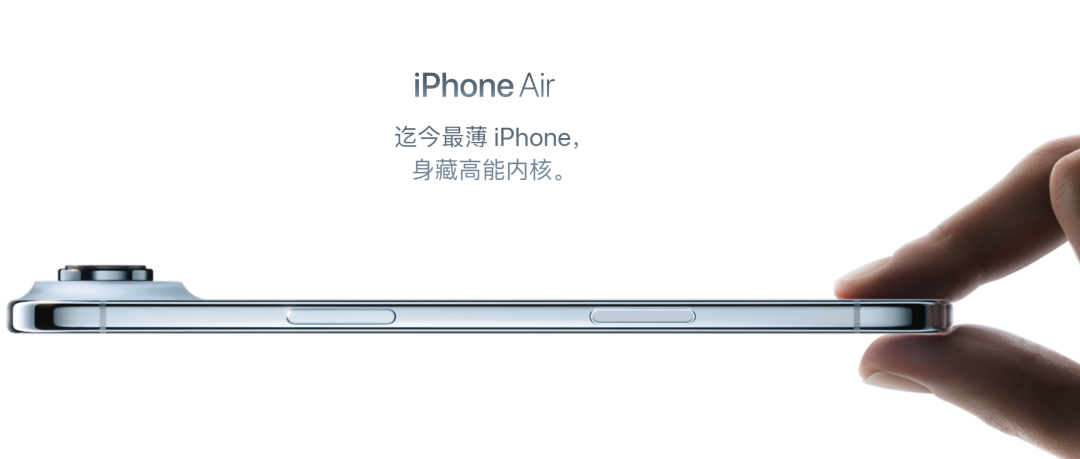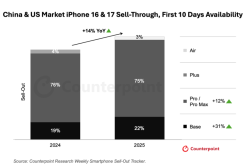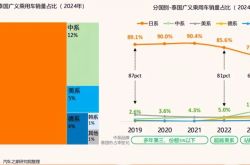Apple Unveils Its Thinnest iPhone Ever in China, Featuring eSIM Support: Are the Big Three Carriers Ready for the Challenge?
![]() 09/12 2025
09/12 2025
![]() 480
480
In the wee hours of September 10, Apple unveiled its most eagerly awaited product launch of the year, with the iPhone Air series taking center stage as 'Apple's slimmest iPhone to date.'

The iPhone Air boasts the cutting-edge A19 Pro processor, Apple's most formidable iPhone chip yet, and is equipped with the Apple-designed C1x modem, boasting speeds twice that of the C1. Additionally, the iPhone Air embraces Apple's innovative N1 chip architecture, supporting Wi-Fi 7, Bluetooth 6, and Thread technology. Despite its sleek design, Apple assures users of all-day battery life, with up to 27 hours of video playback and up to 40 hours when paired with the $99 iPhone Air MagSafe battery.
Beyond its stellar performance, the iPhone Air stands out as the sole iPhone in mainland China currently supporting eSIM, with China Unicom being the exclusive eSIM carrier.
All Three Major Carriers Dive into the eSIM Smartphone Arena
eSIM, an industry-standard digital SIM card embedded within the iPhone, eliminates the need for a physical SIM card. For those unfamiliar with eSIM, the initial query might be, 'What advantages does eSIM offer me?'
Firstly, eSIM is pivotal in crafting slimmer and lighter smartphones. Physically, while a traditional SIM card is diminutive, the card slot, shielding, and ejection mechanism consume significant space within a smartphone. By eliminating the physical SIM card and tray, manufacturers can leverage this freed-up space to enhance battery capacity or even redesign chip layouts to incorporate additional features. Furthermore, fewer device openings translate to better protection against moisture, dust, and water, minimizing the risk of malfunctions. The newly launched iPhone Air, for instance, supports only eSIM, enabling it to achieve a mere 5.6mm thickness and a weight of just 165 grams by forgoing the need for a bulky SIM card slot.
Secondly, eSIM simplifies number portability. Its programmable nature allows it to be written to and erased from the same hardware device, enabling different devices to share the same number seamlessly. For smartphone users, this translates to the freedom to switch carriers effortlessly, utilize dual SIMs for work and personal purposes, or easily manage calls and messages from different numbers without the hassle of complex registration, cancellation, and re-registration processes.
Thirdly, eSIM enhances security. When a phone is stolen, thieves typically discard the SIM card to prevent the owner from tracking or recovering the device. eSIM addresses this issue at its core—without a physical card, it cannot be removed or inserted into another phone. The digital authorization mechanism also empowers carriers to revoke access remotely, thwarting unauthorized use by criminals.
Given eSIM's substantial benefits, why has its adoption in smartphones been sluggish? In reality, there are no technical hurdles to implementing eSIM in phones; its widespread adoption hinges entirely on negotiations between stakeholders. The introduction of eSIM means users can freely switch carriers, inevitably creating conflicts of interest for carriers. Despite these challenges, eSIM has finally achieved some notable milestones.
Currently, China Unicom is the sole supported iPhone eSIM carrier in mainland China. Apple underscores that eSIM functionality on Chinese models is exclusive to the iPhone Air and cannot be installed with eSIMs from non-mainland China carriers. Additionally, users traveling outside mainland China can activate a travel eSIM—signifying that China Unicom is poised to launch its eSIM service with the Apple iPhone Air.
China Telecom has also announced that its eSIM smartphone service is fully primed and anticipates receiving formal approval from the Ministry of Industry and Information Technology for commercial trials soon. Once approved, it will swiftly offer eSIM services, including for the iPhone 17.
Meanwhile, China Mobile has submitted its eSIM application and will commence services upon approval. A China Mobile representative stated that the company already supports eSIM smartphone services and will notify users once services are officially launched.
Apple's Embrace of eSIM Signals a Major Leap for Ecosystem Growth
Before Apple, domestic smartphone manufacturers had already ventured into implementing eSIM. As early as 2021, Lei Jun unveiled the Xiaomi MIX 4 at Xiaomi's autumn product launch, highlighting its new privacy protection features, including an enhanced anti-loss mode powered by built-in eSIM. However, this feature was later scrapped due to non-compliance with national regulations. More recently, rumors suggested that Huawei's Mate XTs might preempt Apple in launching eSIM in China, but this did not materialize when the product was officially released.
Ultimately, Apple took the lead in mainland China. The introduction of eSIM in the iPhone Air is anticipated to spur demand for device upgrades and encourage more domestic manufacturers to follow suit. The active promotion of eSIM by major terminal manufacturers like Apple, Huawei, and Xiaomi holds immense significance for the ecosystem's growth.
It is undeniable that despite years of development, eSIM remains relatively niche. Consumer awareness is particularly low—a survey by Counterpoint Research involving 3,535 respondents from the US, Canada, UK, France, Germany, Poland, and Japan revealed that only 35% were cognizant of eSIM technology, and among those, only 39% were utilizing it.
This indicates that despite efforts by eSIM suppliers, network operators, and device manufacturers to streamline acquisition and activation, adoption remains sluggish. However, it is heartening that over 90% of eSIM users are satisfied with the service, underscoring its key advantages.
 Source: Counterpoint Research Consumer eSIM Awareness Survey
Source: Counterpoint Research Consumer eSIM Awareness Survey
Commenting on the findings, Mohit Agrawal, Research Director at Counterpoint, said, 'Despite eSIM's evident advantages, such as enhanced flexibility and multi-SIM functionality, consumers remain hesitant to fully embrace it. A significant portion still does not comprehend eSIM's full potential. 61% of respondents listed eSIM as their least preferred SIM card connection option. Factors like device compatibility limitations and lack of immediate switching needs lead many to still prefer traditional SIM cards or hybrid models.'
Addressing these barriers through enhanced education and improved user experiences is paramount for driving wider eSIM adoption. Mobile devices like smartphones may be the optimal medium for raising awareness. Siddhant Cally, Research Analyst at Counterpoint, noted, 'The limited availability of eSIM in flagship devices from iPhone and other smartphone manufacturers remains a major impediment to widespread adoption, especially for users without eSIM-compatible devices. This limited compatibility prevents a broader consumer base from fully realizing eSIM's benefits. Widespread adoption will truly take off when eSIM becomes more prevalent in affordable smartphones, which dominate the mobile market, particularly in emerging regions.'
GSMA Intelligence predicts that global eSIM smartphone connections will reach 1 billion by the end of 2025 and could surge to 7 billion by 2030, accounting for about three-quarters of all global smartphone connections.
eSIM: A Must-Have for IoT Devices
While eSIM faces significant hurdles in smartphone adoption, the Internet of Things (IoT) offers a vast expanse for its growth. In fact, eSIM is practically indispensable for IoT devices. Deploying IoT devices often entails massive numbers, and physically replacing SIM cards—as required for smartphones—is impractical for thousands of devices. With eSIM's remote provisioning capabilities, manufacturers can deploy devices on a large scale and manage them more efficiently.
Moreover, eSIM aids smart devices in saving space, enhancing performance, and enabling flexible deployment and easy management. It also facilitates borderless mobility for IoT hardware, meeting the demands of global expansion.
In mid-2023, GSMA released the new eSIM IoT specification SGP.32, a remote provisioning standard that simplifies integration, ensures seamless carrier switching, and accelerates time-to-market, paving the way for large-scale IoT deployments.
According to Juniper Research, by 2026, approximately 6% of global eSIMs are expected to be utilized in IoT applications, with the number of IoT connections using eSIM technology growing from 22 million in 2023 to 195 million.
Looking ahead, as technology matures and global carriers ramp up their support, eSIM will play an increasingly pivotal role in both consumer and IoT sectors.
References:
Latest Updates on eSIM Smartphone Services from China's Three Major Carriers: China Telecom Fully Prepared, China Mobile to Notify Upon Launch (The Paper); All Three Major Carriers Dive into the eSIM Smartphone Arena (China Economic Net); China's First eSIM Smartphone Launches! Carriers Ready to Roll (IoT World); Year After Year... Why Has eSIM Development Fallen Short of Expectations? (IoT Intelligence); It's Time to Re-evaluate eSIM (IoT Intelligence)








